Assessment of the Synergy between Recycling and Thermal Treatments in Municipal Solid Waste Management in Europe
Abstract
:1. Introduction
2. Methodology
3. Results and Discussion
3.1. Municipal Solid Waste Management in the EU
3.2. Bottom and Fly Ash Management in EU
3.2.1. Role of Thermal Treatments
3.2.2. Bottom Ash Qualitative and Quantitative Features
3.2.3. Bottom Ash Treatment
3.2.4. Fly Ash Features and Management
3.3. Future Perspectives in a “Recycling and Thermal Treatments Only” Scenario
- –
- Total MSW amount estimated for 2030 was calculated considering specific waste generation in 2018 (489 kg per capita) [1];
- –
- The estimated population by 2030 was expected as 524 M [17]. Calculations also considered the Eurostat projection data involving higher migration phenomena and the consequent increase of the population to 531 M;
- –
- The achievement by 2030 of the EU targets set for landfilling (10% MSW) and recycling (65% MSW, with 25% thermal treatments) [50].
4. Conclusions
Author Contributions
Funding
Conflicts of Interest
References
- Eurostat (2020): Municipal Waste by Waste Management Operations. Available online: https://appsso.eurostat.ec.europa.eu/nui/show.do?dataset=env_wasmun&lang=en (accessed on 25 July 2020).
- Giannakitsidou, O.; Giannikos, I.; Chondrou, A. Ranking European countries on the basis of their environmental and circular economy performance: A DEA application in MSW. Waste Manag. 2020, 109, 181–191. [Google Scholar] [CrossRef] [PubMed]
- Behzad, M.; Zolfani, S.H.; Pamucar, D.; Behzad, M. A comparative assessment of solid waste management performance in the Nordic countries based on BWM-EDAS. J. Clean. Prod. 2020, 266, 122008. [Google Scholar] [CrossRef]
- Avdiushchenko, A.; Zając, P. Circular economy indicators as a supporting tool for European regional development policies. Sustainability 2019, 11, 3025. [Google Scholar] [CrossRef] [Green Version]
- Van Caneghem, J.; Van Acker, K.; De Greef, J.; Wauters, G.; Vandecasteele, C. Waste-to-energy is compatible and complementary with recycling in the circular economy. Clean Technol. Environ. Policy 2019, 21, 925–939. [Google Scholar] [CrossRef]
- Minelgaitė, A.; Liobikienė, G. The problem of not waste sorting behaviour, comparison of waste sorters and non-sorters in European Union: Cross-cultural analysis. Sci. Total Environ. 2019, 672, 174–182. [Google Scholar] [CrossRef]
- Khandelwal, H.; Dhar, H.; Thalla, A.K.; Kumar, S. Application of life cycle assessment in municipal solid waste management: A worldwide critical review. J. Clean. Prod. 2019, 209, 630–654. [Google Scholar] [CrossRef]
- Laurent, A.; Bakas, I.; Clavreul, J.; Bernstad, A.; Niero, M.; Gentil, E.; Hauschild, M.; Christensen, T.H. Review of LCA studies of solid waste management systems. Part I: Lessons learned and perspectives. Waste Manag. 2019, 34, 573–588. [Google Scholar] [CrossRef]
- Bueno, G.; Latasa, I.; Lozano, P.J. Comparative LCA of two approaches with different emphasis on energy or material recovery for a municipal solid waste management system in Gipuzkoa. Renew. Sustain. Energy Rev. 2015, 51, 449–459. [Google Scholar] [CrossRef]
- Cherubini, F.; Bargigli, S.; Ulgiati, S. Life cycle assessment (LCA) of waste management strategies: Landfilling, sorting plants and incineration. Energy 2009, 34, 2116–2123. [Google Scholar] [CrossRef]
- Istrate, I.R.; Iribarren, D.; Gálvez-Martos, J.L.; Dufour, J. Review of life-cycle environmental consequences of waste-to-energy solutions on the municipal solid waste management system. Resour. Conserv. Recycl. 2020, 157, 104778. [Google Scholar] [CrossRef]
- Scarlat, N.; Fahl, F.; Dallemand, J. Status and opportunities for energy recovery from municipal solid waste in Europe. Waste Biomass Valor. 2019, 10, 2425–2444. [Google Scholar] [CrossRef] [Green Version]
- Eurostat (2020): Population Change—Demographic Balance and Crude Rates at National Level. Available online: https://ec.europa.eu/eurostat/web/population-demography-migration-projections/data/main-tables (accessed on 25 July 2020).
- Eurostat (2020), National Accounts (including GDP). Available online: https://ec.europa.eu/eurostat/web/national-accounts/data/main-tables?p_p_id=NavTreeportletprod_WAR_NavTreeportletprod_INSTANCE_7JJfnOXKXwXl&p_p_lifecycle=0&p_p_state=normal&p_p_mode=view&p_p_col_id=column-2&p_p_col_count=2 (accessed on 25 July 2020).
- Neuwahl, F.; Cusano, G.; Gómez Benavides, J.; Holbrook, S.; Roudier, S. Best Available Techniques (BAT) Reference Document for Waste Incineration: Industrial Emissions Directive 2010/75/EU (Integrated Pollution Prevention and Control); EUR 29971 EN; Publications Office of the European Union: Luxembourg, 2019. [Google Scholar] [CrossRef]
- Lynn, C.J.; Ghataora, G.S.; Dhir OBE, R.K. Municipal incinerated bottom ash (MIBA) characteristics and potential for use in road pavements. Int. J. Pavement Res. Technol. 2017, 10, 185–201. [Google Scholar] [CrossRef]
- Eurostat (2020d): Population on 1st January by Age, Sex and Type of Projection. Available online: https://ec.europa.eu/eurostat/web/population-demography-migration-projections/population-projections-/main-tables (accessed on 25 July 2020).
- Brown, D.P. Garbage: How population, landmass, and development interact with culture in the production of waste. Resour. Conserv. Recycl. 2015, 98, 41–54. [Google Scholar] [CrossRef]
- Khajevand, N.; Tehrani, R. Impact of population change and unemployement rate on Philadephia’s waste disposal. Waste Manag. 2019, 100, 278–286. [Google Scholar] [CrossRef]
- Malinauskaite, J.; Jouhara, H.; Czajczyńska, D.; Stanchev, P.; Katsou, E.; Rostkowski, P.; Thorne, R.J.; Colón, J.; Ponsá, S.; Al-Mansour, F.; et al. Municipal solid waste management and waste-to-energy in the context of a circular economy and energy recycling in Europe. Energy 2017, 141, 2013–2044. [Google Scholar] [CrossRef]
- Dou, X.; Ren, F.; Nguyen, M.Q.; Ahamed, A.; Yin, K.; Chan, W.P.; Chang, V.W.C. Review of MSWI bottom ash utilization from perspectives of collective characterization, treatment and existing application. Renew. Sustain. Energy Rev. 2017, 79, 24–38. [Google Scholar] [CrossRef]
- Astrup, T.; Muntoni, A.; Polettini, A.; Pomi, R.; van Gerven, T.; van Zomeren, A. Treatment and reuse of incineration bottom ash. In Environmental Materials and Waste. Resource Recovery and Pollution Prevention; Prasad, M.N.V., Shih, K., Eds.; Elsevier: Waltham, MA, USA, 2016; pp. 607–645. [Google Scholar] [CrossRef] [Green Version]
- CEWEP. Composition of Bottom Ash Treatment of Bottom Ash Bottom Ash Fact Sheet Use of the Inert Fraction 19–20. 2017. Available online: http://vbsa.ch/wp-content/uploads/2016/07/Studie-Bunge-Internetversion.pdf (accessed on 25 July 2020).
- Allegrini, E.; Maresca, A.; Olsson, M.E.; Holtze, M.S.; Boldrin, A.; Astrup, T.F. Quantification of the resource recovery potential of municipal solid waste incineration bottom ashes. Waste Manag. 2014, 34, 1627–1636. [Google Scholar] [CrossRef]
- Alam, Q.; Schollbach, K.; van Hoek, C.; van der Laan, S.; de Wolf, T.; Brouwers HJ, H. In-depth mineralogical quantification of MSWI bottom ash phases and their association with potentially toxic elements In-depth mineralogical quantification of MSWI bottom ash phases and their association with potentially toxic elements. Waste Manag. 2019, 87, 1–12. [Google Scholar] [CrossRef]
- Funari, V.; Braga, R.; Nadeem, S.; Bokhari, H.; Dinelli, E.; Meisel, T. Solid residues from Italian municipal solid waste incinerators: A source for “critical” raw materials. Waste Manag. 2015, 45, 206–216. [Google Scholar] [CrossRef]
- Thomé-Kozmiensky, E. Abfallverbrennungsanlagen—Deutschland 2016/2017; Thomé-Kozmiensky Verlag GmbH: Neuruppin, Germany, 2018. (In German) [Google Scholar]
- Kahle, K.; Kamuk, B.; Kallesøe, J.; Fleck, E.; Lamers, F.; Jacobsson, L.; Sahlén, J.H. ISWA Report 2015, Bottom Ash from WtE Plants—Metal Recovery and Utilization; International Solid Waste Association: Vienna, Austria, 2015. [Google Scholar]
- Martin, J.J.E.; Koralewska, R.; Wohlleben, A. Advanced solutions in combustion-based WtE technologies. Waste Manag. 2015, 37, 147–156. [Google Scholar] [CrossRef]
- Polettini, A.; Pomi, R. The leaching behavior of incinerator bottom ash as affected by accelerated ageing. J. Hazard. Mater. 2004, 113, 209–215. [Google Scholar] [CrossRef] [PubMed]
- Enzner, V.; Holm, O.; Abis, M.; Kuchta, K. The characterisation of the fine fraction of MSWI bottom ashes fro the pollution and resource potential. In Proceedings of the Sixteenth International Waste Management and Landfill Symposium, Sardinia, Cagliari, Italy, 2–6 October 2017; Cisa Publisher: Padova, Italy, 2017. [Google Scholar]
- Bourtsalas, A. Review of WTE Ash Utilization Processes Under Development in Northwest Europe. Ph.D. Thesis, Imperial College, London, UK, 2017. [Google Scholar]
- Tang, P.; Florea, M.V.A.; Spiesz, P.; Brouwers, H.J.H. Application of thermally activated municipal solid waste incineration (MSWI) bottom ash fines as binder substitute. Cem. Concr. Compos. 2016, 70, 194–205. [Google Scholar] [CrossRef]
- Schafer, M.L.; Clavier, K.A.; Townsend, T.G.; Kari, R.; Worobel, R.F. Assessment of the total content and leaching behavior of blends of incinerator bottom ash and natural aggregates in view of their utilization as road base construction material. Waste Manag. 2019, 98, 92–101. [Google Scholar] [CrossRef] [PubMed]
- Yang, Z.; Ji, R.; Liu, L.; Wang, X.; Zhang, Z. Recycling of municipal solid waste incineration by-product for cement composites preparation. Constr. Build. Mater. 2018, 162, 794–801. [Google Scholar] [CrossRef]
- Di Gianfilippo, M.; Hyks, J.; Verginelli, I.; Costa, G.; Hjelmar, O.; Lombardi, F. Leaching behaviour of incineration bottom ash in a reuse scenario: 12years-field data vs. lab test results. Waste Manag. 2018, 73, 367–380. [Google Scholar] [CrossRef]
- Tang, P.; Florea, M.V.A.; Spiesz, P.; Brouwers, H.J.H. Characteristics and application potential of municipal solid waste incineration (MSWI) bottom ashes from two waste-to-energy plants. Constr. Build. Mater. 2015, 83, 77–94. [Google Scholar] [CrossRef]
- Blasenbauer, D.; Huber, F.; Lederer, J.; Quina, M.J.; Blanc-biscarat, D.; Bogush, A.; Bontempi, E.; Blondeau, J.; Maria, J.; Dahlbo, H.; et al. Legal situation and current practice of waste incineration bottom ash utilisation in Europe. Waste Manag. 2020, 102, 868–883. [Google Scholar] [CrossRef]
- Bunge, R. Recovery of metals from waste incineration bottom ash. In Removal, Treatment and Utilisation of Waste Incineration Bottom Ash; Holm, O., Thome-Kozmiensky, E., Eds.; TK Verlag: Neuruppin, Germany, 2018; pp. 63–143. [Google Scholar]
- Šyc, M.; Simon, F.G.; Hyks, J.; Braga, R.; Biganzoli, L.; Costa, G.; Funari, V.; Grosso, M. Metal recovery from incineration bottom ash: State-of-the-art and recent developments. J. Hazard. Mater. 2020, 393, 1–17. [Google Scholar] [CrossRef]
- Koralewska, R. Recovery of metals from combustion residues. In Waste Management, Recycling, Composting, Fermentation, Mechanical-Biological Treatment, Energy Recovery from Waste, Sewage Sludge Treatment; Thomé-Kozmiensky, K.J., Pelloni, L., Eds.; TK Verlag Karl Thomé-Kozmiensky: Neuruppin, Germany, 2011; Volume 2, pp. 656–671. [Google Scholar]
- European Commission Joint Research Centre. Study on Methodological Aspects Regarding Limit Values for Pollutants In Aggregates in the Context of the Possible Development of End-Of-Waste Criteria Under the EU Waste Framework Directive. 2014. Available online: http://susproc.jrc.ec.europa.eu/ (accessed on 25 July 2020).
- Morf, L.; Brunner, P.; Spaun, S. Effect of operating conditions and input variations on the partitioning of metals in a municipal solid waste incinerator. Waste Manag. 2002, 18, 4–15. [Google Scholar] [CrossRef]
- Holm, O.; Hansen, E.; Lassen, C.; Stuer-Lauridsen, F.; Kjolholt, J. Heavy Metals in Waste; Final report, 2002 ENV.E.3/ETU/2000/0058; COWI A/S: Copenhagen, Denmark, 2002. [Google Scholar]
- Song, G.J.; Kim, K.H.; Seo, Y.C.; Kim, S.C. Characteristics of ashes from different locations at the MSW incinerator equipped with various air pollution control devices. Waste Manag. 2004, 24, 99–106. [Google Scholar] [CrossRef]
- Bayuseno, A.P.; Schmahl, W.W. Characterization of MSWI fly ash through mineralogy and water extraction. Resour. Conserv. Recycl. 2011, 55, 524–534. [Google Scholar] [CrossRef]
- Aubert, J.E.; Husson, B.; Sarramone, N. Utilization of municipal solid waste incineration (MSWI) fly ash in blended cement. Part 1: Processing and characterization of MSWI fly ash. J. Hazard. Mater. 2011, 136, 624–631. [Google Scholar] [CrossRef] [PubMed]
- Huber, F.; Laner, D.; Fellner, J. Comparative life cycle assessment of MSWI fly ash treatment and disposal. Waste Manag. 2018, 73, 392–403. [Google Scholar] [CrossRef] [PubMed]
- Quina, M.J.; Bontempi, E.; Bogush, A.; Schlumberger, S.; Weibel, G.; Braga, R.; Funari, V.; Hyks, J.; Rasmussen, E.; Lederer, J. Science of the total environment technologies for the management of MSW incineration ashes from gas cleaning: New perspectives on recovery of secondary raw materials and circular economy. Sci. Total Environ. 2018, 635, 526–542. [Google Scholar] [CrossRef] [PubMed]
- European Commission. Waste—Review of Waste Policy and Legislation. Available online: http://ec.europa.eu/environment/waste/target_review.htm (accessed on 25 July 2020).
- European Commission. Communication from the Commission to the European Parliament, the Council, the European Economic and Social Committee and the Committee of the Regions. The Role of Waste-To-Energy in the Circular Economy. Brussels. 2017. Available online: http://ec.europa.eu/environment/waste/waste-to-energy.pdf (accessed on 25 July 2020).
- Wilts, H.; Galinski, L.; Marin, G.; Paleari, S.; Zoboli, R. Assessment of Waste Incineration Capacity and Waste Shipments in Europe; ETC/WMGE; European Environment Agency, European Topic Centre on Waste and Materials in a Green Economy: Copenhagen, Denmark, 2017. [Google Scholar]
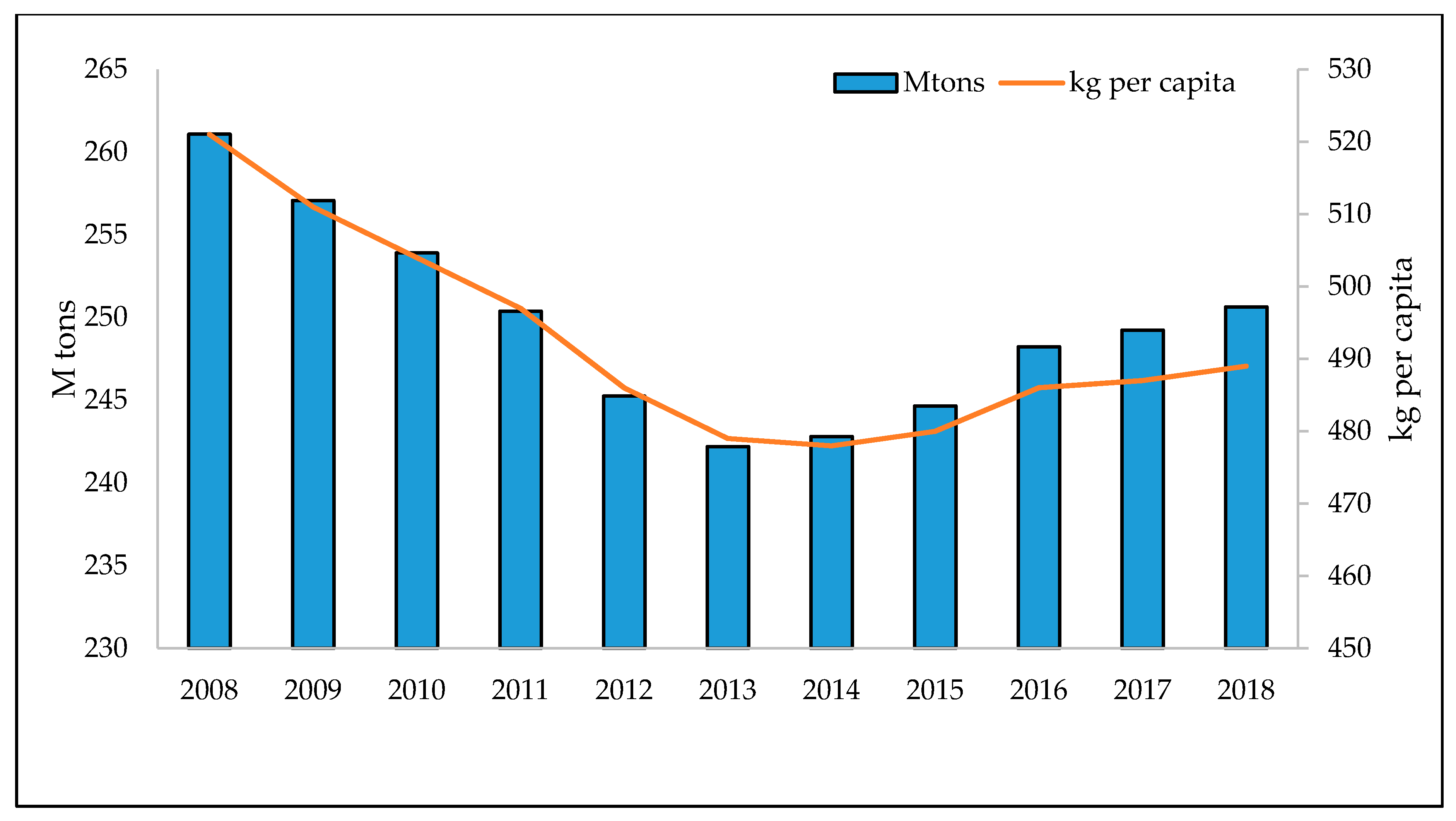
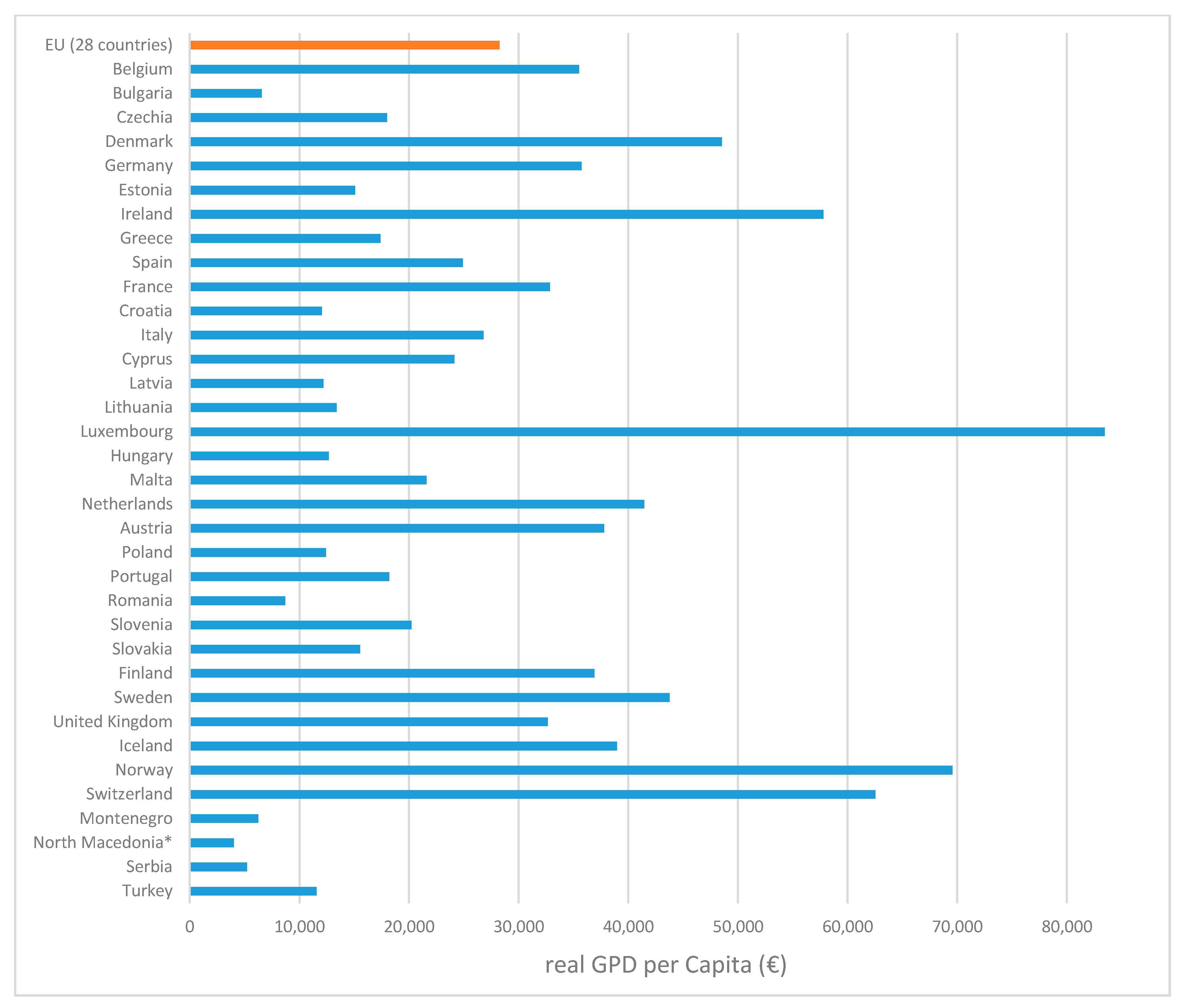
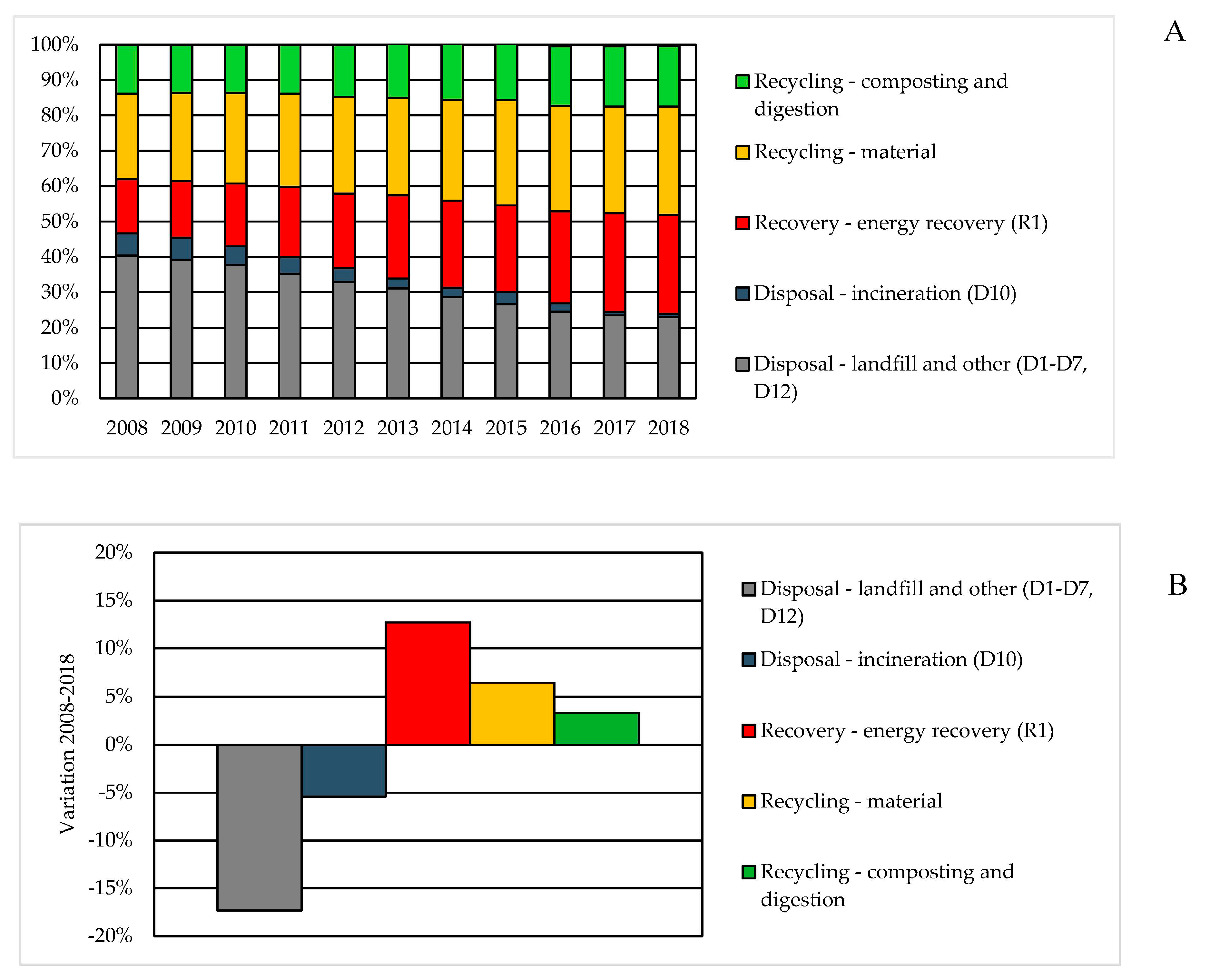
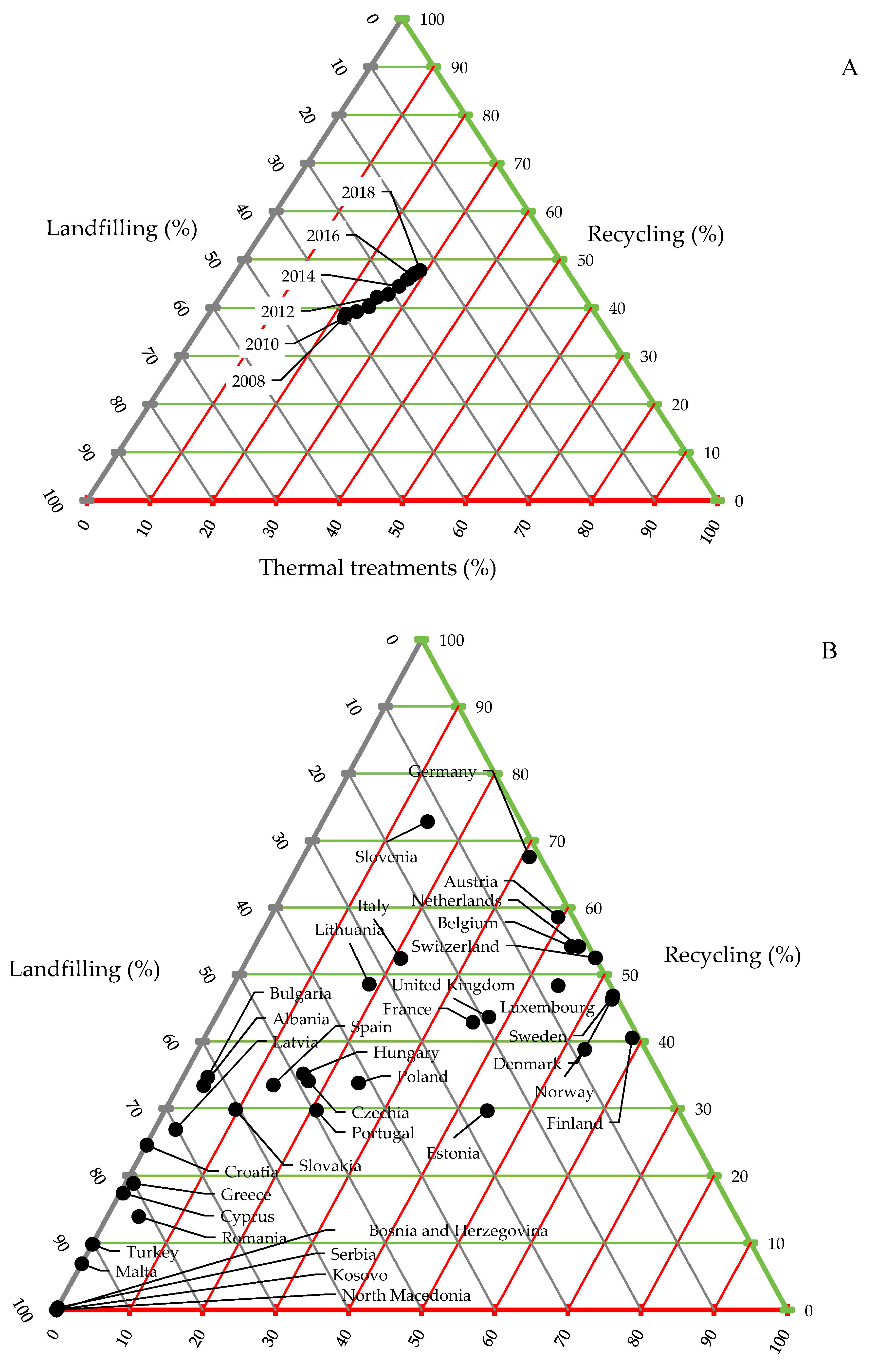
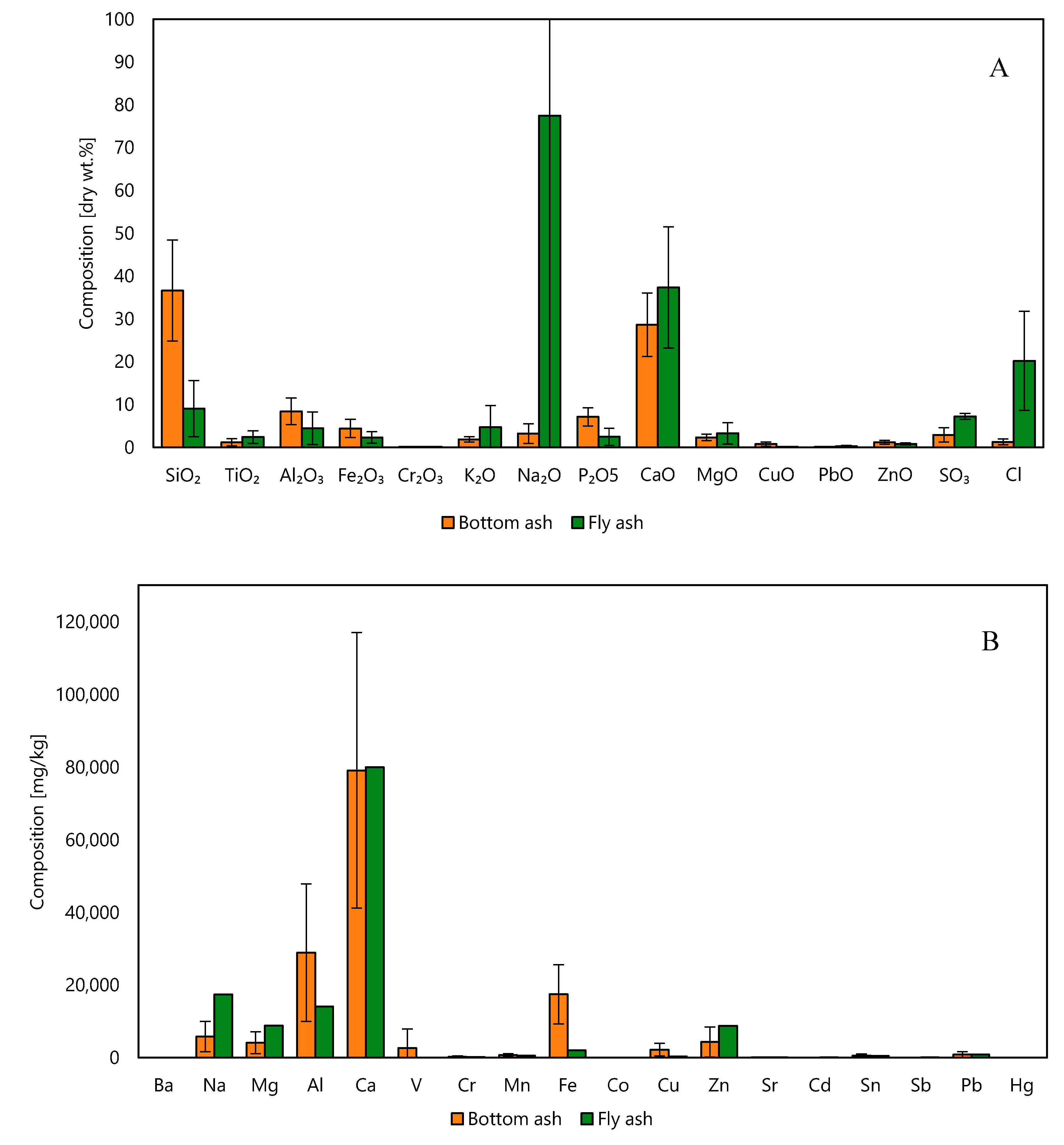
| 2018 (Actual Situation) | 2030 (Baseline Projections) | 2030 (Higher Migration) | ||||
|---|---|---|---|---|---|---|
| Population (residents) | 512,372,000 | 524,000,000 | 531,000,000 | |||
| MSW generated (t) | 250,642,000 | 255,188,000 | 258,597,000 | |||
| Landfilling (t) | 56,743,000 | (23 wt %) | 25,518,800 | (10 wt %) | 25,859,700 | (10 wt %) |
| Thermal treatments (t) | 72,701,000 | (29 wt %) | 63,797,000 | (25 wt %) | 64,649,250 | (25 wt %) |
| Recycling (t) | 121,198,000 | (48 wt %) | 165,872,200 | (65 wt %) | 168,088,050 | (65 wt %) |
Publisher’s Note: MDPI stays neutral with regard to jurisdictional claims in published maps and institutional affiliations. |
© 2020 by the authors. Licensee MDPI, Basel, Switzerland. This article is an open access article distributed under the terms and conditions of the Creative Commons Attribution (CC BY) license (http://creativecommons.org/licenses/by/4.0/).
Share and Cite
Abis, M.; Bruno, M.; Kuchta, K.; Simon, F.-G.; Grönholm, R.; Hoppe, M.; Fiore, S. Assessment of the Synergy between Recycling and Thermal Treatments in Municipal Solid Waste Management in Europe. Energies 2020, 13, 6412. https://doi.org/10.3390/en13236412
Abis M, Bruno M, Kuchta K, Simon F-G, Grönholm R, Hoppe M, Fiore S. Assessment of the Synergy between Recycling and Thermal Treatments in Municipal Solid Waste Management in Europe. Energies. 2020; 13(23):6412. https://doi.org/10.3390/en13236412
Chicago/Turabian StyleAbis, Marco, Martina Bruno, Kerstin Kuchta, Franz-Georg Simon, Raul Grönholm, Michel Hoppe, and Silvia Fiore. 2020. "Assessment of the Synergy between Recycling and Thermal Treatments in Municipal Solid Waste Management in Europe" Energies 13, no. 23: 6412. https://doi.org/10.3390/en13236412
APA StyleAbis, M., Bruno, M., Kuchta, K., Simon, F.-G., Grönholm, R., Hoppe, M., & Fiore, S. (2020). Assessment of the Synergy between Recycling and Thermal Treatments in Municipal Solid Waste Management in Europe. Energies, 13(23), 6412. https://doi.org/10.3390/en13236412








